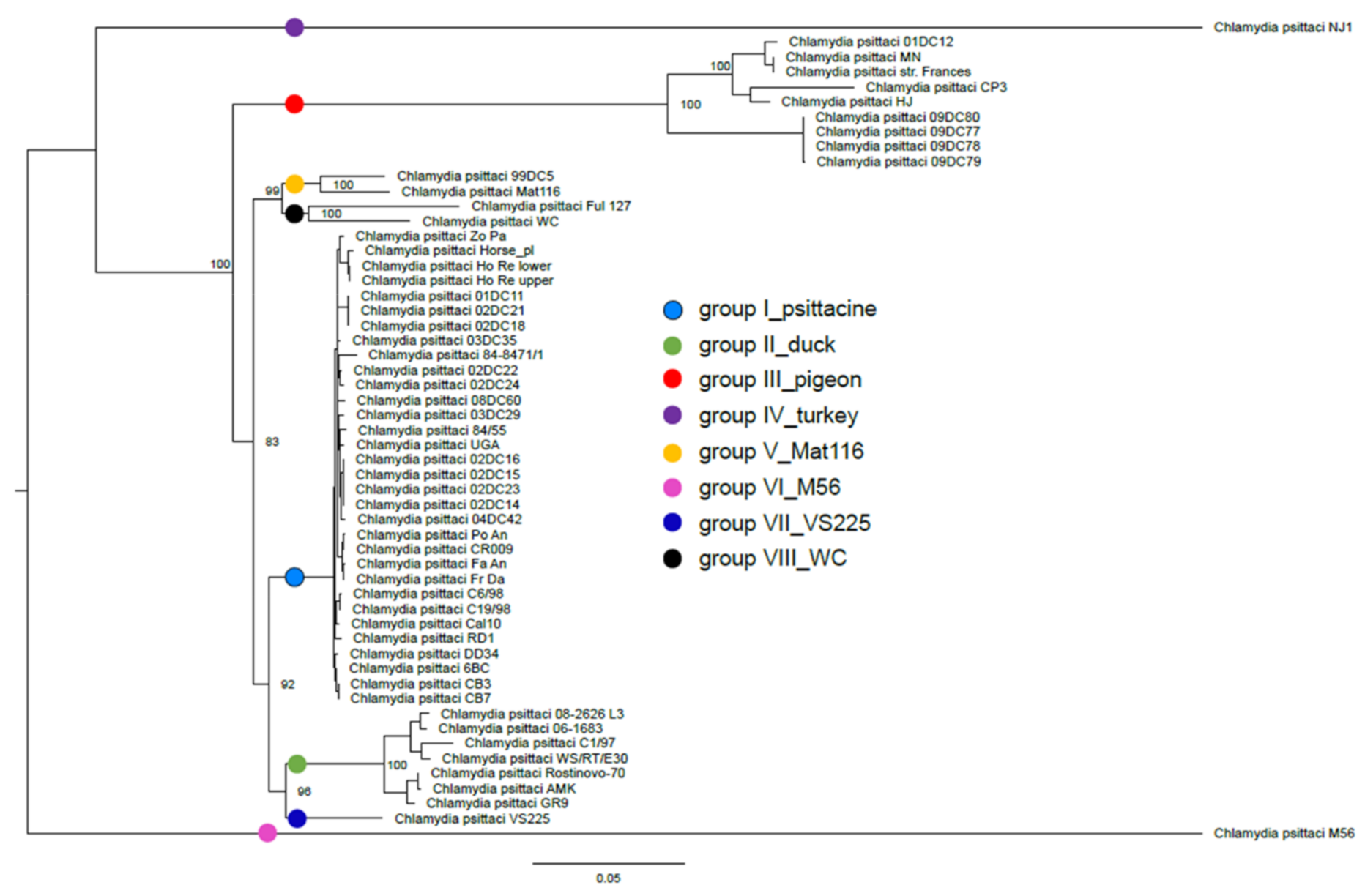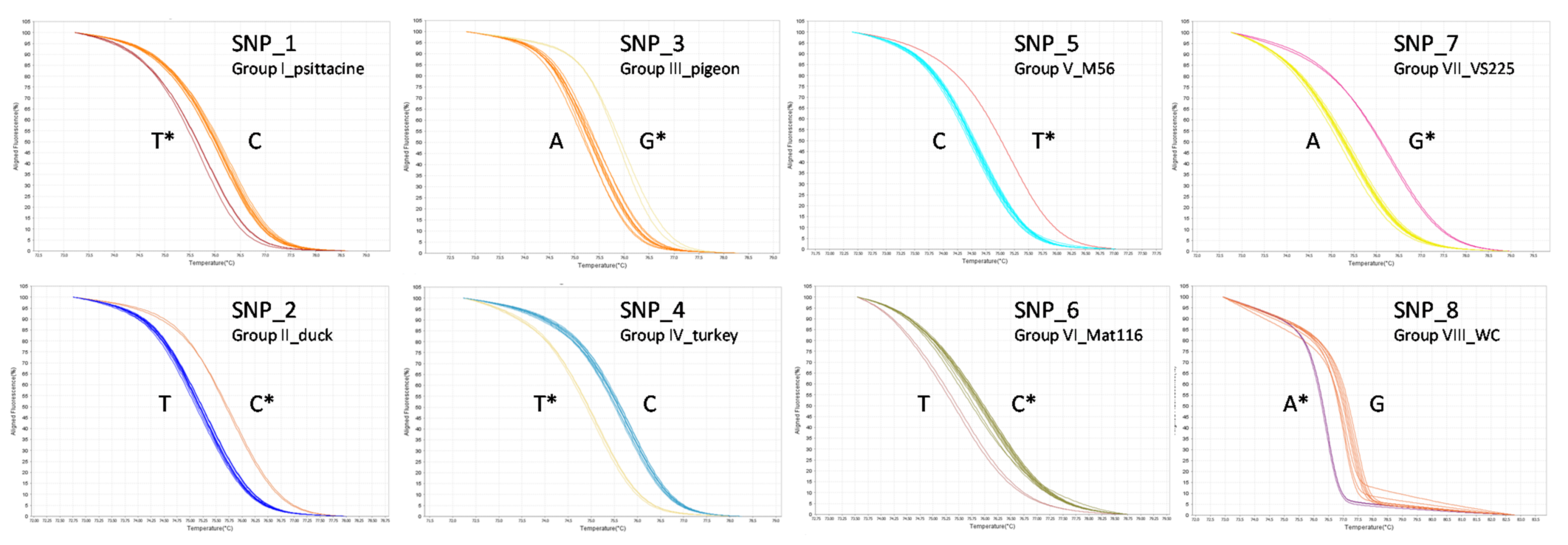A New SNP-Based Genotyping Method for C. psittaci: Application to Field Samples for Quick Identification
Abstract
1. Introduction
2. Materials and Methods
2.1. Bacterial Strains and Isolates
2.2. Whole Genome Phylogenetic Analysis and Selection of PCR-HRM Markers
2.3. PCR-HRM Assay
2.4. ompA and MLST Typing
2.5. In-Silico MLST Typing
3. Results and Discussion
Supplementary Materials
Author Contributions
Funding
Institutional Review Board Statement
Informed Consent Statement
Data Availability Statement
Conflicts of Interest
References
- Kaleta, E.F.; Taday, E.M.A. Avian host range of Chlamydophila spp. based on isolation, antigen detection and serology. Avian Pathol. 2003, 32, 435–461. [Google Scholar] [CrossRef]
- Balsamo, G.; Maxted, A.M.; Midla, J.W.; Murphy, J.M.; Wohrle, R.; Edling, T.M.; Fish, P.H.; Flammer, K.; Hyde, D.; Kutty, P.K.; et al. Compendium of Measures to Control Chlamydia psittaci Infection Among Humans (Psittacosis) and Pet Birds (Avian Chlamydiosis). J. Avian Med. Surg. 2017, 31, 262–282. [Google Scholar] [CrossRef] [PubMed]
- Hogerwerf, L.; Roof, I.; de Jong, M.J.K.; Dijkstra, F.; van der Hoek, W. Animal sources for zoonotic transmission of psittacosis: A systematic review. BMC Infect. Dis. 2020, 20, 192. [Google Scholar] [CrossRef]
- Andersen, A.A. Serotyping of Chlamydia psittaci isolates using serovar-specific monoclonal antibodies with the microimmunofluorescence test. J. Clin. Microbiol. 1991, 29, 707–711. [Google Scholar] [CrossRef] [PubMed]
- Andersen, A.A. Two new serovars of Chlamydia psittaci from North American birds. J. Vet. Diagn. Investig. 1997, 9, 159–164. [Google Scholar] [CrossRef]
- Vanrompay, D.; Butaye, P.; Sayada, C.; Ducatelle, R.; Haesebrouck, F. Characterization of avian Chlamydia psittaci strains using omp1 restriction mapping and serovar-specific monoclonal antibodies. Res. Microbiol. 1997, 148, 327–333. [Google Scholar] [CrossRef]
- Sachse, K.; Laroucau, K.; Hotzel, H.; Schubert, E.; Ehricht, R.; Slickers, P. Genotyping of Chlamydophila psittaci using a new DNA microarray assay based on sequence analysis of ompA genes. BMC Microbiol. 2008, 8, 63. [Google Scholar] [CrossRef] [PubMed]
- Szymańska-Czerwińska, M.; Mitura, A.; Niemczuk, K.; Zaręba, K.; Jodełko, A.; Pluta, A.; Scharf, S.; Vitek, B.; Aaziz, R.; Vorimore, F.; et al. Dissemination and genetic diversity of chlamydial agents in Polish wildfowl: Isolation and molecular characterisation of avian Chlamydia abortus strains. PLoS ONE 2017, 12, e0174599. [Google Scholar] [CrossRef]
- Pannekoek, Y.; Dickx, V.; Beeckman, D.S.A.; Jolley, K.A.; Keijzers, W.C.; Vretou, E.; Maiden, M.C.J.; Vanrompay, D.; van der Ende, A. Multi locus sequence typing of Chlamydia reveals an association between Chlamydia psittaci genotypes and host species. PLoS ONE 2010, 5, e14179. [Google Scholar] [CrossRef]
- Brunelle, B.W.; Sensabaugh, G.F. Nucleotide and phylogenetic analyses of the Chlamydia trachomatis ompA gene indicates it is a hotspot for mutation. BMC Res. Notes 2012, 5, 53. [Google Scholar] [CrossRef][Green Version]
- Van Loock, M.; Vanrompay, D.; Herrmann, B.; Vander Stappen, J.; Volckaert, G.; Goddeeris, B.M.; Everett, K.D.E. Missing links in the divergence of Chlamydophila abortus from Chlamydophila psittaci. Int. J. Syst. Evol. Microbiol. 2003, 53, 761–770. [Google Scholar] [CrossRef]
- Voigt, A.; Schöfl, G.; Heidrich, A.; Sachse, K.; Saluz, H.P. Full-length de novo sequence of the Chlamydophila psittaci type strain, 6BC. J. Bacteriol. 2011, 193, 2662–2663. [Google Scholar] [CrossRef] [PubMed][Green Version]
- Schöfl, G.; Voigt, A.; Litsche, K.; Sachse, K.; Saluz, H.P. Complete genome sequences of four mammalian isolates of Chlamydophila psittaci. J. Bacteriol. 2011, 193, 4258. [Google Scholar] [CrossRef] [PubMed]
- Seth-Smith, H.M.; Sait, M.; Sachse, K.; Gaede, W.; Longbottom, D.; Thomson, N.R. Genome Sequence of Chlamydia psittaci Strain 01DC12 Originating from Swine. Genome Announc. 2013, 1, e00078-12. [Google Scholar] [CrossRef] [PubMed]
- Chu, J.; Sun, R.; Wu, Z.; Liu, S.; Li, D.; Zhang, Q.; Ling, Y.; Gong, Y.; Wu, R.; Wu, H.; et al. Whole-Genome Sequences of Low-Virulence Strain CB3 and Mild Strain CB7 of Chlamydia psittaci. Genome Announc. 2014, 2, e00456-14. [Google Scholar] [CrossRef] [PubMed]
- Zhang, Q.; Wu, Z.; Sun, R.; Chu, J.; Han, E.; Zhang, Y.; Ling, Y.; Gong, Y.; Li, D.; Wu, H.; et al. Whole-Genome Sequences of Chlamydia psittaci Strain HJ, Isolated from Meat Pigeons with Severe Respiratory Distress and High Mortality. Genome Announc. 2015, 3, e00035-15. [Google Scholar] [CrossRef]
- Laroucau, K.; de Barbeyrac, B.; Vorimore, F.; Clerc, M.; Bertin, C.; Harkinezhad, T.; Verminnen, K.; Obeniche, F.; Capek, I.; Bébéar, C.; et al. Chlamydial infections in duck farms associated with human cases of psittacosis in France. Vet. Microbiol. 2009, 135, 82–89. [Google Scholar] [CrossRef] [PubMed]
- Sachse, K.; Laroucau, K.; Riege, K.; Wehner, S.; Dilcher, M.; Creasy, H.H.; Weidmann, M.; Myers, G.; Vorimore, F.; Vicari, N.; et al. Evidence for the existence of two new members of the family Chlamydiaceae and proposal of Chlamydia avium sp. nov. and Chlamydia gallinacea sp. nov. Syst. Appl. Microbiol. 2014, 37, 79–88. [Google Scholar] [CrossRef]
- Pantchev, A.; Sting, R.; Bauerfeind, R.; Tyczka, J.; Sachse, K. New real-time PCR tests for species-specific detection of Chlamydophila psittaci and Chlamydophila abortus from tissue samples. Vet. J. 2009, 181, 145–150. [Google Scholar] [CrossRef]
- Huang, W.; Li, L.; Myers, J.R.; Marth, G.T. ART: A next-generation sequencing read simulator. Bioinformatics 2012, 28, 593–594. [Google Scholar] [CrossRef]
- Stamatakis, A. RAxML version 8: A tool for phylogenetic analysis and post-analysis of large phylogenies. Bioinformatics 2014, 30, 1312–1313. [Google Scholar] [CrossRef]
- Untergasser, A.; Nijvee, H.; Rao, X.; Bisseling, T.; Geurts, R.; Leunissen, J.A.M. Primer3Plus, an enhanced web interface to Primer3. Nucleic Acids Res. 2007, 35, W71–W74. [Google Scholar] [CrossRef] [PubMed]
- Kaltenboeck, B.; Kousoulas, K.G.; Storz, J. Structures of and allelic diversity and relationships among the major outer membrane protein (ompA) genes of the four chlamydial species. J. Bacteriol. 1993, 175, 487–502. [Google Scholar] [CrossRef] [PubMed]
- Sachse, K.; Laroucau, K.; Vorimore, F.; Magnino, S.; Feige, J.; Müller, W.; Kube, S.; Hotzel, H.; Schubert, E.; Slickers, P.; et al. DNA microarray-based genotyping of Chlamydophila psittaci strains from culture and clinical samples. Vet. Microbiol. 2009, 135, 22–30. [Google Scholar] [CrossRef] [PubMed]
- Henning, K.; Sachse, K.; Sting, R. Demonstration of Chlamydia from an equine abortion. Dtsch. Tierärztl. Wochenschr. 2000, 107, 49–52. [Google Scholar] [PubMed]
- Wang, H.; Jensen, J.K.; Olsson, A.; Vorimore, F.; Aaziz, R.; Guy, L.; Ellström, P.; Laroucau, K.; Herrmann, B. Chlamydia psittaci in fulmars on the Faroe Islands: A causative link to South American psittacines eight decades after a severe epidemic. Microbes Infect. 2020, 22, 356–359. [Google Scholar] [CrossRef] [PubMed]


| HRM Group | Strain/Sample | ID |
|---|---|---|
| I_Psittacine | reference strains | 6BC-04DC45, Loth, VS1 |
| field strains with typing data | 84-6461, 84-8471/1, 84-9462, 85-1173, 85-12098, 86-0191, 86-10703, 86-14356, 86-3389, 87-13654, 88-2014, 88-5558, 88-5821, 88-8795, 89-2930, 90-0057, 90-0475, 90-10445, 90-11404, 90-12937, 90-4862, 91-14273, 91-5189, 91-6047, 95-1334, 97-5075, 97-6475, 98-7627, 99-0182, 99-0923, 99-8157/1, 00-0151, 00-0476, 00-1176, 00-1268, 00-1750, 05-0949, 05-4098, 06-0372, 06-0852, C6/98, 01DC11, 03DC29, 03DC35, 04DC42, 04DC46 | |
| field strains without typing data | 96-6274, 96-12328, 96-12742, 97-822, 97-9244, 99-0313, 99-1394, 99-8888, 00-4462, 03-3227, 04-2668, 10-0485, 10-1735 | |
| clinical samples | 10-1735 *, 17-10114, 17-10090 | |
| II_Duck | reference strain | GR9 |
| field strains with typing data | 94-2306, 05-4325, 05-4461, 06-859, 06-871, 06-881, 06-889, 06-1683, 10-1398/28, 10-1400, C1/97, 07-1391, 08-2626_L3, 08-2626_L4 | |
| field strains without typing data | 04-5006, 05-553/17, 07-2962, 08-2850, 10-1393 | |
| clinical samples | 15-46D/8, 15-53D/8, 15-41/8, 15-63/3, 16-1264_MJC, 16-1264_JL1, 16-1264_JL2, 17-5203, 2008_A, 2009_A, 20-3954_C054 | |
| III_Pigeon | reference strains | CP3, Cal10, MN |
| field strains with typing data | 90-12617, 91-6568, 91-12516, 89-13210, 91-5983, 05-4036, 09-295_JF5, 09-295_JF8, 09-295_J9, 09-295_MB32, 09-295_MB33, 09-336_FA30634, 09-487_T13, 09-489_LP5, 09-489_LP7, 09-489_Mon5, 09-489_Mon13, 09-496_FA32303, 09-496_FA32311, 09-544_Van14, 09-589_S10, 09-928, 10-743_SC1, 10-881_SC22, 10-743_SC24, 10-743_SC28, 10-743_SC33, 10-743_SC42, 10-881_SC42, 10-883_EL27, 10-1048_Bat16, 01DC12, 03DC32, 09DC75, 11DC94 | |
| field strain without typing data | 10-2168 | |
| clinical samples | 15-8D/13, 15-57D/2, 10-743_SC1 *, 10-743_SC22 *, 10-743_SC24 *, 10-743_SC28 *, 10-743_SC33 *, 10-2168 *, 16-1264_VE, 20-1105_A036, 20-1105_A039 | |
| IV_Turkey | reference strains | NJ1, TT3 |
| V_Mat116 | field strain with typing data | 99DC05 |
| clinical samples | 20-1105_A041, 19-5617_I078_G2662, 19-5617_I080_K12016 | |
| VI_M56 | reference strain | M56-07DC57 |
| field strain with typing data | 16DC111 | |
| clinical samples | 12-2090_P088, 12-1950_M074 | |
| VII_VS225 | reference strain | VS225 |
| VIII_WC | reference strain | WC-07DC58 |
| field strain with typing data | Ful127 |
| SNP for Each Group | ||||||||||||
|---|---|---|---|---|---|---|---|---|---|---|---|---|
| SNP No. | Associated Group | Group I | Group II | Group III | Group IV | Group V | Group VI | Group VII | Group VIII | Position on 6BC | Gene | Locus Tag |
| (Psittacine) | (Duck) | (Pigeon) | (Turkey) | (M56) | (Mat116) | (VS225) | (WC) | |||||
| 1 | Group I_Psittacine | T | C | C | C | C | C | C | C | 126074 | lipoate-protein ligase family protein | CPSIT_RS00640 |
| 2 | Group II_Duck | T | C | T | T | T | T | T | T | 39653 | CesT family type III secretion system chaperone | CPSIT_RS00155 |
| 3 | Group III_Pigeon | A | A | G | A | A | A | A | A | 1038463 | cation-translocating P-type ATPas | CPSIT_RS04480 |
| 4 | Group IV_Turkey | C | C | C | T | C | C | C | C | 1352 | Na(+)-translocating NADH-quinone reductase subunit A | CPSIT_RS00010 |
| 5 | Group V_M56 | C | C | C | C | T | C | C | C | 961 | hemB | CPSIT_RS00005 |
| 6 | Group VI_Mat116 | T | T | T | T | T | C | T | T | 85629 | anti-sigma regulatory factor | CPSIT_RS00375 |
| 7 | Group VII_VS225 | A | A | A | A | A | A | G | A | 13908 | exodeoxyribonuclease V subunit gamma | CPSIT_RS00045 |
| 8 | Group VIII_WC | G | G | G | G | G | G | G | A | 722388 | YqgE/AlgH family protein | CPSIT_RS03140 |
| SNP No. | Associated Group | Forward Primer (5′-3′) | Reverse Primer (5′-3′) | Amplicon Size (bp) |
|---|---|---|---|---|
| 1 | Group I_Psittacine | gacccaacgagatttctgga | cccaaagacatttgccttaca | 94 |
| 2 | Group II_Duck | gcgatctcgtcaagatacgtg | ttggtatccgaagaaggaggt | 94 |
| 3 | Group III_Pigeon | cttctttcttgcaggaactccag | atccgaaagctgctgacgtc | 101 |
| 4 | Group IV_Turkey | aagaaccctaacatgcacgc | ggcgatgaaaatccctgttgt | 81 |
| 5 | Group V_M56 | tgatgtgttgcatcgagtga | ccactgacttgataggctgct | 63 |
| 6 | Group VI_Mat116 | cgcttcttggtatgcataggag | agaacaactcaaaacattcccaa | 100 |
| 7 | Group VII_VS225 | aagggagtcagaagaagagaaaa | actaatgctacgagtaaccacg | 63 |
| 8 | Group VIII_WC | tgaacaggaatgcaaaagca | tgggtttagaaatagctgacga | 119 |
Publisher’s Note: MDPI stays neutral with regard to jurisdictional claims in published maps and institutional affiliations. |
© 2021 by the authors. Licensee MDPI, Basel, Switzerland. This article is an open access article distributed under the terms and conditions of the Creative Commons Attribution (CC BY) license (http://creativecommons.org/licenses/by/4.0/).
Share and Cite
Vorimore, F.; Aaziz, R.; de Barbeyrac, B.; Peuchant, O.; Szymańska-Czerwińska, M.; Herrmann, B.; Schnee, C.; Laroucau, K. A New SNP-Based Genotyping Method for C. psittaci: Application to Field Samples for Quick Identification. Microorganisms 2021, 9, 625. https://doi.org/10.3390/microorganisms9030625
Vorimore F, Aaziz R, de Barbeyrac B, Peuchant O, Szymańska-Czerwińska M, Herrmann B, Schnee C, Laroucau K. A New SNP-Based Genotyping Method for C. psittaci: Application to Field Samples for Quick Identification. Microorganisms. 2021; 9(3):625. https://doi.org/10.3390/microorganisms9030625
Chicago/Turabian StyleVorimore, Fabien, Rachid Aaziz, Bertille de Barbeyrac, Olivia Peuchant, Monika Szymańska-Czerwińska, Björn Herrmann, Christiane Schnee, and Karine Laroucau. 2021. "A New SNP-Based Genotyping Method for C. psittaci: Application to Field Samples for Quick Identification" Microorganisms 9, no. 3: 625. https://doi.org/10.3390/microorganisms9030625
APA StyleVorimore, F., Aaziz, R., de Barbeyrac, B., Peuchant, O., Szymańska-Czerwińska, M., Herrmann, B., Schnee, C., & Laroucau, K. (2021). A New SNP-Based Genotyping Method for C. psittaci: Application to Field Samples for Quick Identification. Microorganisms, 9(3), 625. https://doi.org/10.3390/microorganisms9030625






